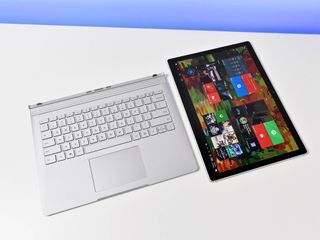
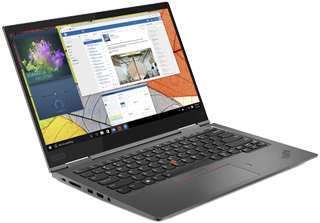
Business-Oriented Convertible
Lenovo's fourth-generation ThinkPad X1 Yoga brings 10th Gen Intel Core processors (CPU), many security options, and wide connectivity to a business-oriented convertible. It has inking support for the touch display, and its keyboard and touchpad are some of the best around.
For
- Frequent sales drop the price significantly
- 10th Gen Intel hardware available
- Plenty of extra security features
- Optional LTE connectivity and better port selection
- Excellent keyboard and Precision touchpad
Against
- Price without deals is high
- No dedicated GPU option
- Display tops out at 1440p with 16:9 aspect ratio
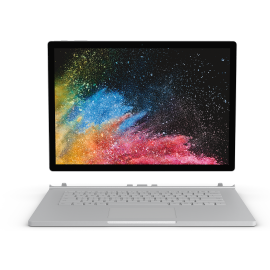
Premium 2-in-1 Ultrabook
Microsoft's Surface Book 2 is no doubt due for a refresh, but that doesn't mean it's not still a formidable 2-in-1 Ultrabook. Choose from 13.5- and 15-inch touch display sizes, add a discrete GPU for extra performance, and take advantage of the comfortable keyboard and touchpad for productivity work.
For
- Available in 13.5- and 15-inch sizes
- Discrete GPU available
- Beautiful high-res touch display
- Comfortable keyboard and Precision touchpad
- Built to a premium standard
Against
- Port selection is limited
- Hardware due for an upgrade
- Prices climb quickly
While the size of these laptops doesn't really match up — the X1 Yoga is 14 inches while the Surface Book 2 is either 13.5 or 15 inches — they're likely still on the same shortlist for anyone who wants a device with inking support, respectable performance, and a high build quality. Let's break down the differences and similarities between these laptops to help you get an idea of which is best for your needs.
ThinkPad X1 Yoga (Gen 4) vs. Surface Book 2 tech specs
| Header Cell - Column 0 | ThinkPad X1 Yoga (Gen 4) | Surface Book 2 (13.5) | Surface Book 2 (15) |
|---|---|---|---|
| Processor | 8th Gen Intel Core i5-8265U Core i7-8565U Core i7-8665U vPro 10th Gen Intel Core i7-10510U Core i7-10710U vPro | 7th Gen Intel Core i5-7300 8th Gen Intel Core i5-8350U Core i7-8650U | 8th Gen Intel Core i5-8350U Core i7-8650U |
| RAM | 8GB, 16GB LPDDR3-2133MHz | 8GB, 16GB LPDDR3-1866MHz | 16GB LPDDR3-1866MHz |
| Storage | 256GB, 512GB, 1TB PCIe SSD | 256GB, 512GB, 1TB PCIe SSD | 256GB, 512GB, 1TB PCIe SSD |
| Display size | 14 inches 16:9 aspect ratio | 13.5 inches 3:2 aspect ratio | 15 inches 3:2 aspect ratio |
| Display resolution | 1920x1080 (FHD) 2560x1440 (WQHD) | 3000x2000 | 3240x2160 |
| Graphics | Intel UHD 620 Graphics Intel UHD Graphics | Intel UHD 620 Graphics NVIDIA GTX 1050 | Intel UHD 620 Graphics | NVIDIA GTX 1060 |
| Ports | Two Thunderbolt 3 Two USB-A 3.1 HDMI 1.4 Ethernet Extension 3.5mm audio | Two USB-A 3.1 USB-C SD card reader Two Surface Connect 3.5mm audio | Two USB-A 3.1 USB-C SD card reader Two Surface Connect 3.5mm audio |
| Wireless | 802.11ac (Wi-Fi 5) Bluetooth 5.0 4G LTE (optional) | 802.11ac (Wi-Fi 5) Bluetooth 4.1 | 802.11ac (Wi-Fi 5) Bluetooth 4.1 |
| Camera | Front-facing 720p | Front-facing 1080p Rear-facing 1080p | Front-facing 1080p Rear-facing 1080p |
| Security | IR camera (optional) Fingerprint reader FIDO dTPM 2.0 ThinkShutter Kensington lock slot PrivacyGuard (optional) PrivacyAlert (optional) | IR camera TPM 2.0 | IR camera TPM 2.0 |
| Battery | 51Wh | 70Wh | 80Wh |
| Dimensions | 12.71 x 8.58 x 0.61 inches (323mm x 218mm x 15.5mm) | 12.3 x 9.14 x 0.51-0.90 inches (312mm x 232mm x 13-23mm | 13.5 x 9.87 x 0.57-0.90 inches (343mm x 251mm x 15-23mm) |
| Weight | From 2.99 pounds (1.35kg) | From 3.38 pounds (1.53kg) | 4.20 pounds (1.91kg) |
Design and features
Both the ThinkPad X1 Yoga and both sizes of the Surface Book 2 can be used as a tablet, but they take a different route to get there. The X1 Yoga is a standard convertible with hinge system that allows the lid to fold around 360 degrees for tablet mode and everything in between. The Book 2 is more of a 2-in-1, with a separate tablet that attaches to a keyboard and performance hardware base. The tablet can operate on its own — and in fact can be reattached to the base backwards for a stand look — but when separated you won't get the full performance or battery life.
The Book 2 is no doubt going to make a better tablet simply due to the fact that it can be removed from the base to shed most of its weight. However, taking apart the Book 2 isn't as convenient as folding the X1 Yoga's lid around, and you also have a keyboard base lying around when not in use. It's a bit clunky.
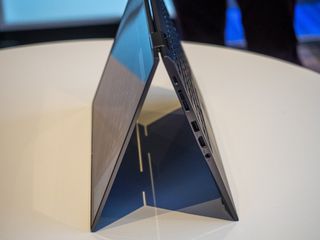
These laptops are built to a premium standard and you shouldn't worry about quality in either. They use magnesium to keep weight down, though you will find that the X1 Yoga weighs considerably less than both sizes of the Book 2. That's partly due to the inclusion of an optional dedicated GPU in the Book 2.
If you plan on taking your laptop into situations outside of the usual office setting, the X1 Yoga's MIL-STD 810G certification is going to give you far more peace of mind. The Book 2 isn't exactly soft, but it's no doubt no going to fare quite as well as the X1 Yoga when it comes to dust and moisture.
The X1 Yoga, thanks to its business leaning, also comes packed with extra security features. A fingerprint reader is standard, you can add an IR camera for facial recognition, there's a webcam shutter and optional privacy display cover, and the usual TPM 2.0 chip, optional FIDO authentication, and Kensington lock slot. The Book 2 comes with a TPM 2.0 chip and IR camera, but it's lacking some of the advanced features that are common in a ThinkPad.
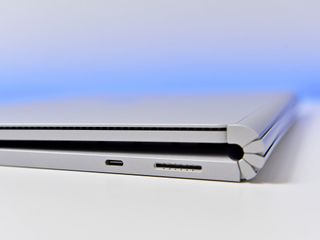
Port selection has never really been a strong point for Surface devices, and the creeping age of the Book 2 doesn't help. It has two USB-A, one USB-C, two Surface Connect ports, 3.5mm audio, and an SD card reader. Compared to the X1 Yoga, with its two Thunderbolt 3, two USB-A, HDMI, Ethernet Extension, and 3.5mm audio, the Book 2 doesn't hold up. At least it offers an SD card reader, which the X1 Yoga lacks. Also scoring a point for Lenovo's laptop is optional 4G LTE connectivity. If you need to stay connected everywhere, Wi-Fi or not, it's going to make a much better choice.
Get the Windows Central Newsletter
All the latest news, reviews, and guides for Windows and Xbox diehards.
Both laptops offer stellar keyboard and Precision touchpads, and a final decision should come down to personal preference. If you type a lot, either option should suit you well. One area where the Book 2 models excel is in their cameras. Whereas the X1 Yoga has a single front-facing 720p camera, the Book 2 offers front- and rear-facing 1080p cameras that will deliver a much clearer picture.
Display and inking
Choosing a laptop in terms of display, at least between these options, should come down to whether you prefer color accuracy and brightness (X1 Yoga) or 3:2 aspect ratio and higher resolution (Book 2).
The 13.5-inch Surface Book 2 comes with a 3000x2000 resolution, while the 15-inch Book 2 has a 3240x2160 resolution. Both use a 3:2 aspect ratio for a boxier look that ultimately offers more screen real estate. These displays are sRGB color accurate, both nearly hitting 100% gamut coverage. Both work with the mighty Surface Pen and Surface Dial that altogether deliver a satisfying inking experience that's designed for professionals.
The X1 Yoga has four different 16:9 displays to choose from. The first has a standard 1920x1080 resolution and can hit about 380 nit brightness. One step up is essentially the same, but it includes a Privacy Guard that allows only those directly facing the screen to see what's displayed. The third option is again almost the same as the standard FHD display, but it is low power to suck up the least amount of battery. Finally, the 2560x1440 option has a higher resolution but only manages about 280 nits brightness. A ThinkPad Pen Pro is included with all models and has a dedicated silo built right into the laptop.
If you value privacy or really want to extend battery life you will find fitting options with the X1 Yoga, but otherwise the Book 2 options are going to look a lot better and besides deliver that 3:2 aspect ratio that's much better suited for life as a tablet.
Price and performance
Comparing performance, it's clear that the Book 2 models with dedicated GPUs are going to deliver much more graphics power. The X1 Yoga only has dedicated graphics, and while the GPUs in the Book 2 are showing their age, they still easily win. In terms of processing power, due to the option of 10th Gen Intel Core chips in the X1 Yoga, it tops the Book 2's 8th Gen Intel chips. It's expected the Surface Book 3 will sport the newer hardware, but until then the X1 Yoga is going to win out. Another important note is DIY upgrades after purchase. The Book 2 is a closed system, whereas you can open up the X1 Yoga and replace the fast SSD. The Book 2 is stuck with relatively slow storage.
Battery life in these laptops is going to be similar. The Book 2 can push about 10 hours when the GPU isn't going strong, but dips down when all systems are go. The X1 Yoga averages about eight hours, but the low power FHD display option no doubt gives it a boost. You should expect to be able to get through a standard workday with both laptops.
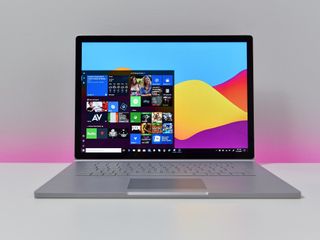
As for pricing, Lenovo's setup can, as usual, make things a bit confusing. Introductory X1 Yoga models retail for about $2,329, but a coupon that's automatically applied brings it down to about 1,199. That's for a model with 8th Gen Intel Core i5 CPU. If you want 10th Gen Intel, you're looking at a starting price of about $1,638 after the coupon is applied.
The 13.5-inch Book 2 starts at about $1,129 and comes with a 7th Gen Intel Core i5 CPU, 8GB of RAM, 128GB SSD, and no dedicated GPU. Amazon does have a great deal on a 13.5-inch model with dedicated NVIDIA GTX 1050 GPU, 8th Gen Intel Core i7 CPU, 8GB of RAM, and 256GB SSD that'll set you back only about $1,099. As for the 15-inch model, prices start at about $1,845 and only go up from there. A configuration with Intel Core i7 CPU, 16GB of RAM, 1TB SSD, and NVIDIA GTX 1060 GPU costs about $2,430.
Go with the ThinkPad X1 Yoga for a more modern device
Modern ports, 10th Gen Intel Core CPUs, plenty of security features, and a durable build designed to withstand punishment make the ThinkPad X1 Yoga quite attractive. It doesn't have as nice a display and won't deliver the same inking experience — especially with the Book 2's modular design — but it's still the right choice for most people who need a new business partner.

Convertible ThinkPad goodness
Get the look and features associated with a ThinkPad and wrap them all up in a convertible chassis. The X1 Yoga will fit in as well at a cafe as in a boardroom.
Stick with the Surface Book 2 for extra performance
The Surface Book 2 is certainly showing its age, but it is the right choice if you prefer a higher-res display, superior inking experience, and dedicated GPU options. It doesn't have as many ports and it lacks some of the X1 Yoga's security features, but it is built extremely well and can be had at a reduced price due to its age.

Modular high-end Surface
The Surface Book 2, available in two sizes, brings dedicated GPU, high-res touch display with inking, and premium build quality that's hard to find elsewhere.

Cale Hunt brings to Windows Central more than eight years of experience writing about laptops, PCs, accessories, games, and beyond.
